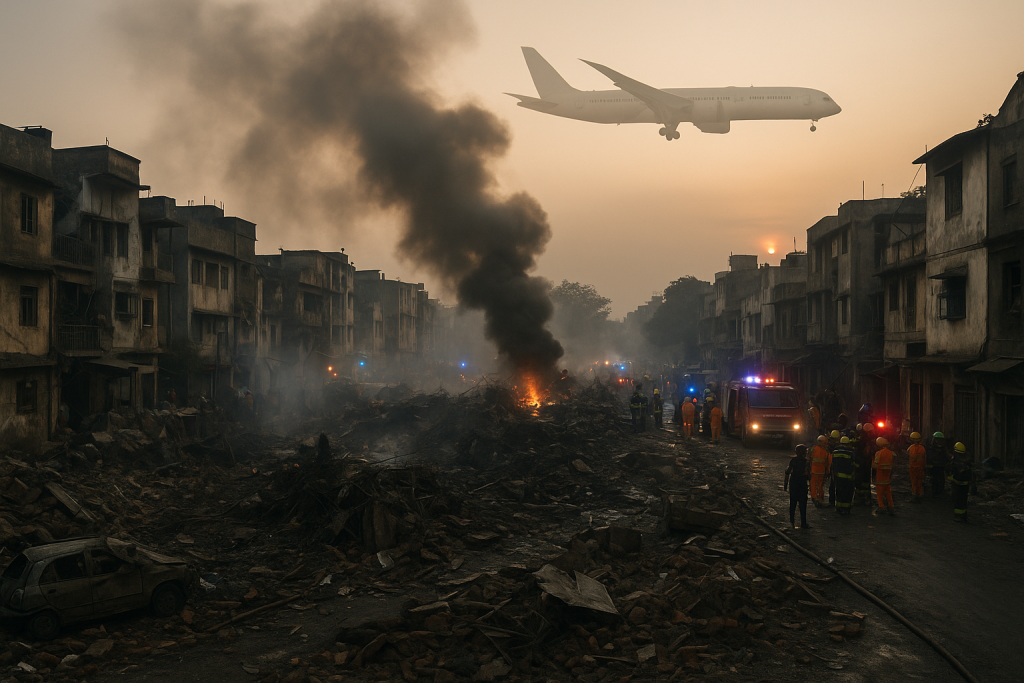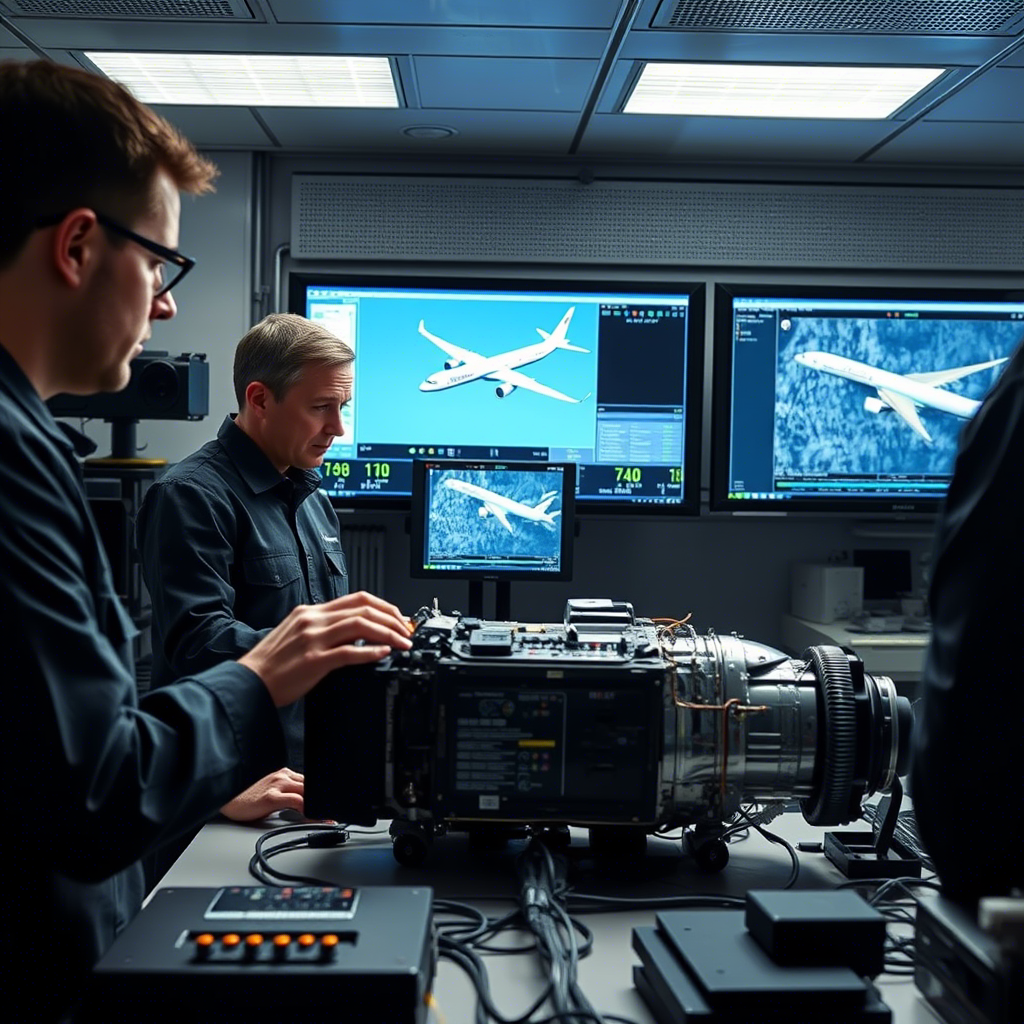A devastating aviation disaster struck India on the morning of June 12, when Air India Flight 171, a Boeing 787-8 Dreamliner bound for London Gatwick, crashed just moments after takeoff from Sardar Vallabhbhai Patel International Airport. The aircraft plunged into the densely populated Meghani Nagar neighborhood, claiming at least 204 lives, including that of former Gujarat Chief Minister Vijay Rupani. Only one person, a 29-year-old British-Indian passenger, survived the crash with critical injuries.

The aircraft, tail number VT-ANB, had been in service since 2014 and had logged over 39,450 flight hours. Shortly after departure, the Dreamliner reached an altitude of just 625 feet before a sudden descent ended in tragedy less than a minute into flight. Preliminary radar data and emergency recordings confirm that the flight crew issued a mayday call and that the Ram Air Turbine (RAT)—a backup power system activated only in the most critical of failures—was deployed.
While traditional lines of inquiry such as engine failure, bird strike, or pilot error remain central to the investigation, growing attention is now turning to a quieter but equally complex possibility: whether the Boeing 787’s highly automated, AI-assisted systems might have played an unintended role. Not as the cause of failure, but as a critical part of the modern cockpit whose behavior under extreme pressure deserves close scrutiny.
The Dreamliner: Flying on the Wings of Artificial Intelligence
Since its debut, the Boeing 787 Dreamliner has symbolized the future of commercial aviation. It is known for its fuel efficiency, composite fuselage, and long-haul comfort. But beyond its physical design, the Dreamliner is also a triumph of embedded technology. At its heart lies a sophisticated digital brain — a fusion of real-time computing, automation, and artificial intelligence (AI) tools.
Central among these is the Integrated Modular Avionics (IMA) system. Unlike older aircraft where each system operated in isolation, the IMA architecture allows various functions — flight control, engine performance monitoring, communication, and system diagnostics — to run on shared computing platforms. This interconnectivity enables intelligent data fusion, faster decision-making, and system-level fault management. Additionally, tools like the Synthetic Vision System (SVS), which uses AI to generate 3D terrain overlays on cockpit displays, assist pilots in maintaining situational awareness even in poor visibility.

These AI-enhanced systems are designed to support — not replace — the pilots. They manage enormous amounts of data and offer automation in routine phases of flight, while also flagging anomalies in real time. In many cases, this has significantly improved safety. But as the industry has learned in recent years, increased automation brings both benefits and new forms of complexity.
A Loud Bang, a Sudden Descent, and Unanswered Questions
According to survivor Vishwash Kumar Ramesh, the final moments before the crash were preceded by a “loud bang” — a clue that investigators are now treating with high priority. This could point to engine failure, a structural breach, or possibly a power management issue that spiraled into a loss of control. The General Electric GEnx engines, which power the Dreamliner fleet, are typically reliable, but mechanical failures cannot be ruled out.
The deployment of the RAT further suggests that the aircraft experienced either a dual engine failure or a major electrical fault. What investigators will now look for in the flight data recorder (FDR) and cockpit voice recorder (CVR) is whether the AI-managed systems — particularly those tied to flight control or power management — received erroneous input, misinterpreted sensor data, or delayed critical decisions in those precious seconds.
It is important to note that AI is not being blamed, but rather evaluated as part of a complex network of interacting systems. Just as in medicine or autonomous vehicles, AI in aviation is not infallible — but nor is it inherently dangerous. It is only as reliable as the quality of its inputs, the architecture of its decision trees, and the safeguards designed around it.
Recent Software Concerns Amplify Vigilance
This tragedy comes just months after a February 2025 advisory by the U.S. Federal Aviation Administration (FAA), which warned of a glitch in the 787’s Very High Frequency (VHF) radio system. The software bug, discovered during routine operations, caused unpredictable switching between active and standby frequencies — a risk that could impair communications during critical phases like takeoff.
Although Boeing released a patch, some airlines, including Qatar Airways, continued to report issues. The FAA was in the process of drafting a fresh Airworthiness Directive to address broader software stability concerns. Whether Flight 171 was affected by this or a related software malfunction remains unclear — but investigators will undoubtedly examine whether any communication errors, data conflicts, or timing failures occurred within the AI-supported cockpit.
Caution, Not Alarm
Experts across the aviation sector caution against jumping to conclusions. “The 787’s AI systems are highly reliable and extensively tested across millions of flight hours,” said Captain Rakesh Sharma, a former 787 pilot and flight safety consultant. “But in aviation, you analyze every element — software, hardware, human input. A crash is rarely the result of a single point of failure. It’s often a convergence.”
His views are echoed by Dr. Sanjay Patel, a systems engineer at the Indian Institute of Science. “The integration of AI in modern aircraft has raised the bar for safety in many respects. But we must also respect the fact that algorithms can only perform as expected under conditions they were designed and tested for. Edge cases, like rare combinations of electrical or sensor anomalies, can still present a challenge.”
This nuanced view reflects an emerging consensus: that AI in aviation is neither savior nor saboteur. It is a powerful tool whose role must be understood holistically — not isolated or scapegoated.
A History of Cautionary Lessons
The Boeing 787 has faced software issues in the past. In 2015, a widely publicized bug was found in the Dreamliner’s power control system, where all generator control units could shut down after 248 consecutive days of operation — an integer overflow-like issue. Though no in-flight incidents occurred due to routine maintenance cycles, it highlighted the need for rigorous oversight of even obscure software behaviors.

More recently, whistleblowers raised alarms in 2024 over potential quality control lapses at Boeing’s Charleston assembly facility. These included reports of incomplete fuselage inspections and procedural shortcuts during component integration. Boeing has denied that these issues posed any immediate safety risks. However, the backdrop of these concerns adds complexity to the Flight 171 investigation.
A Nation in Mourning
The tragedy has sent shockwaves through India. The loss of 204 lives, including numerous families, professionals, and prominent individuals, has triggered a nationwide outpouring of grief. Among the victims were a schoolteacher traveling for a family reunion, a young couple on their honeymoon, and public servant Vijay Rupani.
Prime Minister Narendra Modi, in a nationally televised address, called the crash “a wound on the nation’s heart.” He announced federal assistance for victims’ families and pledged full cooperation with international aviation authorities. The Gujarat government has also offered support to the residents of Meghani Nagar, where dozens of homes were destroyed by the impact and subsequent fire.
Air India has grounded its 787 fleet pending preliminary findings and offered ₹1 crore (~$117,000) in compensation to the families of those who perished.
Toward a Safer Future
As investigators sift through wreckage and decode the aircraft’s black boxes, they will look not just for what failed — but why. Was it a mechanical chain reaction, a lapse in human decision-making, or a software miscalculation within AI systems trying to respond in real time?
The answers will shape global aviation policies. If AI systems are found to have behaved incorrectly, even if only under extraordinary conditions, this crash may prompt a global recalibration of how AI software in commercial jets is validated, tested, and regulated. But the outcome could just as well reaffirm the importance of balanced design — where human pilots and AI systems act as partners, each with strengths, fail-safes, and limitations.

In this shared space between man and machine, trust must be earned through transparency, engineering, and learning from every loss — no matter how painful. Flight 171’s story, ultimately, is not just about a crash. It’s about the delicate choreography of technology, skill, and responsibility in the skies we all share.
Copyrights: Dhaka.ai



